
Throughout recorded history, a good knife has been proven time and time again to be an indispensable tool for survival. From ancient civilizations to the modern era, this trusty companion has been the lifeline for pioneers, adventurers, and survivalists alike, helping them conquer the real dangers the world has thrown their way. Whether settling new frontiers or navigating today’s unique challenges, a good knife remains an enduring symbol/tool of preparedness and resilience.
A Legacy of Survival
The history of the survival knife is steeped in the legacy of human survival. Back in the days of our ancestors, when much of the world was new and untamed, and danger lurked around every corner, a good knife could often mean the difference between life and death. From crafting essential everyday tools to defending against predators and people, the knife was the ultimate multitool of ancient times.
As civilizations evolved and frontiers were settled, the knife remained a steadfast companion.
The Importance of Carrying a Good Knife.
Fast forward to the present day, and the world we have been left with remains as unpredictable as ever. Natural disasters, backcountry problems, urban chaos, and social unrest can strike without warning. While we have more tools at our disposal than at any other time in history, a good knife continues to be an essential survival tool.
For modern survivalists and preppers, the survival knife remains an essential tool in their preparedness toolkit. Its usefulness is unmatched, capable of taking on multiple tasks – from cutting firewood to building shelters and even providing a means of self-defense; when the shit hits the fan, a quality knife becomes the trusted ally in the fight for survival.
What to Look for in a Survival Knife
First, stay away from anything that looks like it came out of the latest zombie movie or crash-landed right out of a bad 80s action film. Sure, that flashy Rambo-style knife might look cool, but let’s be honest— in the real world, it serves almost no practical purpose. When it comes to choosing a reliable and functional survival knife, we need to set aside Hollywood gimmicks and focus on the features that truly matter.
Here is what we look for in a Good Survival Knife
1. Full-Tang Construction:
The foundation of a good survival knife lies in its construction, and that starts with the knife’s tang. A full tang is essential in a survival knife because it offers unparalleled strength and reliability. Unlike partial tang knives, which have a weak point where the blade and handle meet, full tang knives are constructed from a single piece of steel extending through the entire handle length. This design ensures that the knife is solid and less prone to breakage, even under intense pressure and use.
In survival situations, a knife is not just a tool; it becomes your lifeline. Whether you’re chopping wood, building shelter, or processing food, a full-tang knife delivers the reliability and balance required to get the job done.
2. Blade Construction:
Choosing the right blade shape and size is another crucial aspect of picking the right survival knife. There are literally dozens of different shapes, sizes, and blade profiles to choose from, so the choice primarily comes down to personal preferences and intended real-world usage.
For many, the drop-point blade stands out as the all-around best choice for survival knives. This shape perfectly balances strength, functionality, and ease of use. When it comes to blade size, bigger is not always better – no matter what your last girlfriend told you! Too large a blade can, and tasks like dressing small game or carving become more challenging. Pick a blade that is too small, and it won’t provide enough chopping power or batoning capability.
We like a blade length between 4 to 7 inches, with an overall knife length around 10 to 11 inches. Going beyond 11 inches may make the knife unwieldy and impractical in a lot of situations.
Blade thickness is another important consideration. A good survival knife should have enough thickness (around 0.17 to 0.25 inches) to withstand heavy-duty tasks like batoning without compromising its ability to handle more delicate work. Finding the sweet spot in blade thickness ensures a survival knife that excels in a wide range of situations and provides maximum durability and functionality.
3. Blade Materials: D2 or 1095 High Carbon Steel:
The steel used in the blade’s construction significantly impacts its performance. High carbon tool steel, such as D2 or 1095, is the preferred choice for a survival knife. These steels are easy to sharpen, hold an edge well, and are reliable for continued outdoor use.
What Knives do we carry at OFFGRID Survival?
Personally I am a blade junkie; I have a wide variety of cutting tools in my collection. But I do find myself often picking a couple of them as my primary every-day carry chooses. These are usually the ones that I tend to grab.
The SOG Seal Pup Elite
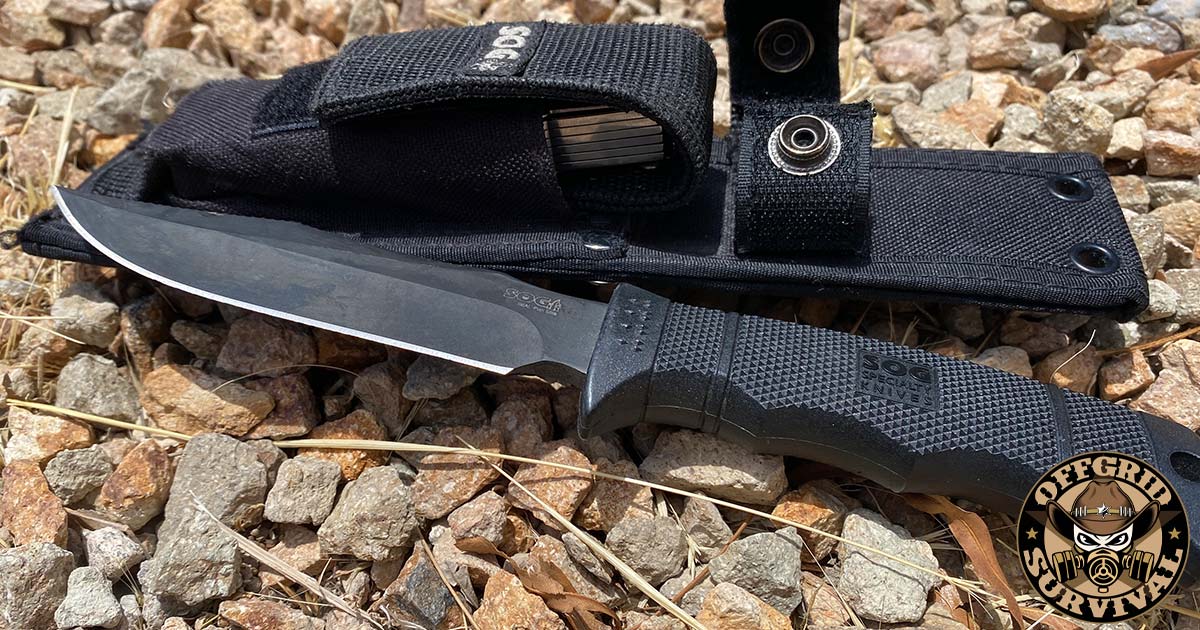
This has been my go-to knife for over a decade. Whether I am out in the backcountry or fly fishing a river somewhere deep in the mountains or just on my way to the local hardware store the SOG Seal Pup is usually on my side — and inside the SOG sheath is usually my SOG PowerLock Multi-Tool.
Morakniv Companion Fixed Blade Outdoor Knife
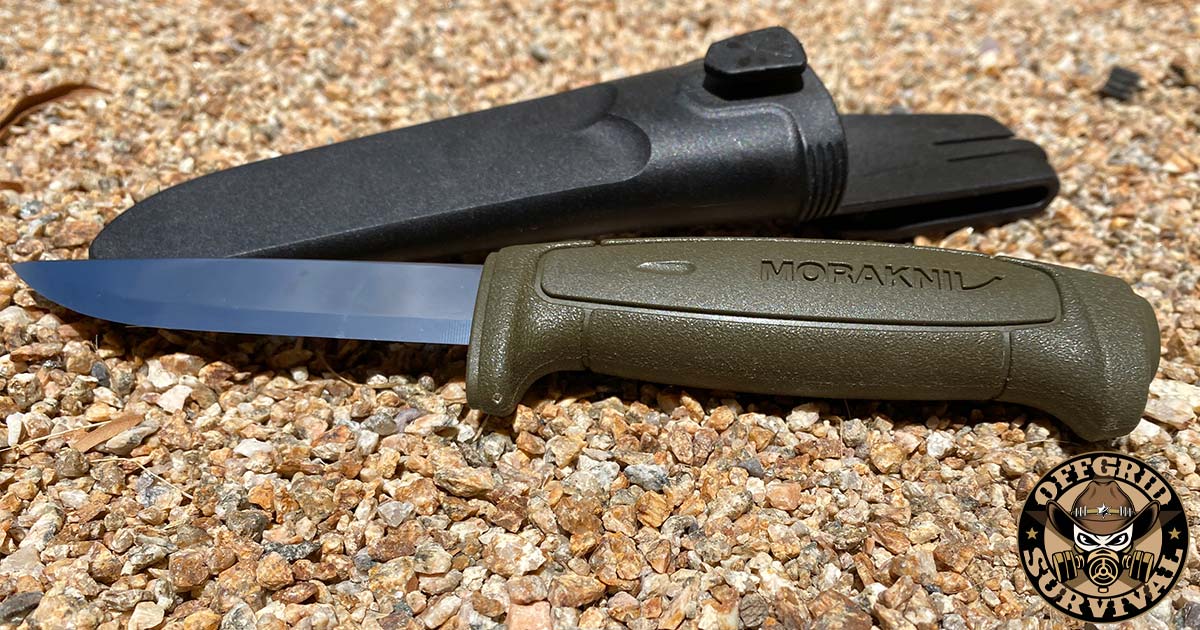
With all of that said, I tend to use cheaper blades for day-to-day cutting. Yes, I carry my SOG for emergencies (and I do use it quite a a bit when I am out fishing)….. but I worry less about damaging the blade when I use a $15 – $20 one for daily work. Believe it or not there are a lot of very good knives out there for under $20, specifically the Morakniv Companion Fixed Blade Outdoor Knife.
For more Fixed Blade Knife recommendations, check out our article on Picking the Best Survival Knife: Reviews of our Top Fixed Blade Survival Knives.
Other Types of Knives we routinely carry.
The Good Old Swiss Army Knife
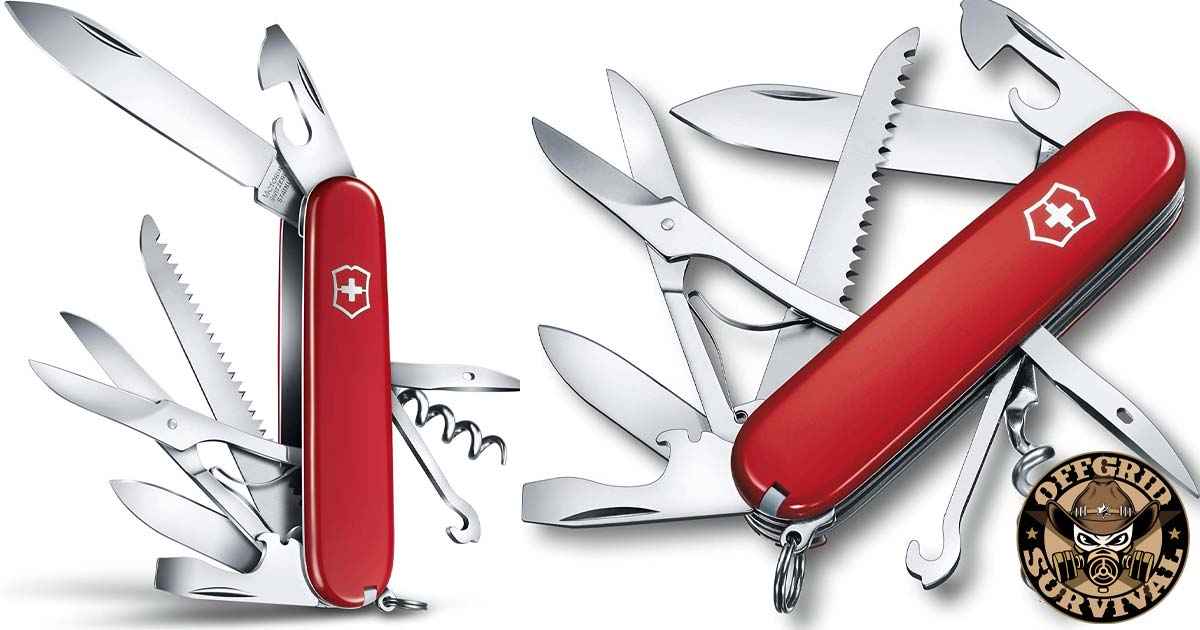
Swiss Army knives still remain a staple in my gear collection. I find them to be fantastic little tools that easily slip into small survival kits, go-bags, and emergency vehicle kits. Despite their small size, these knives are incredibly durable and versatile, offering a number of useful tools such as blades, screwdrivers, and can openers.
SOG Powelock Multitool
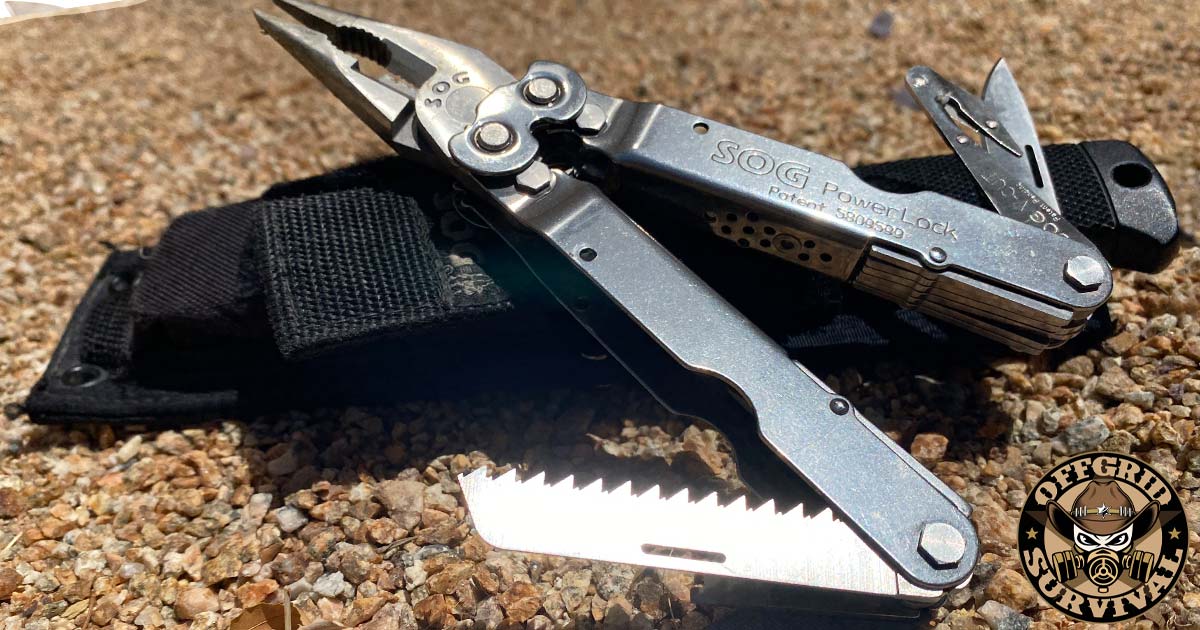
Although I don’t think of this as a typical knife, I do carry a SOG Multitool on a daily basis and it does have a couple of different blades in it. In fact, I have been carrying the same SOG multitool for over a decade now, and let me tell you this thing is a workhorse!
Husky Utility Blades
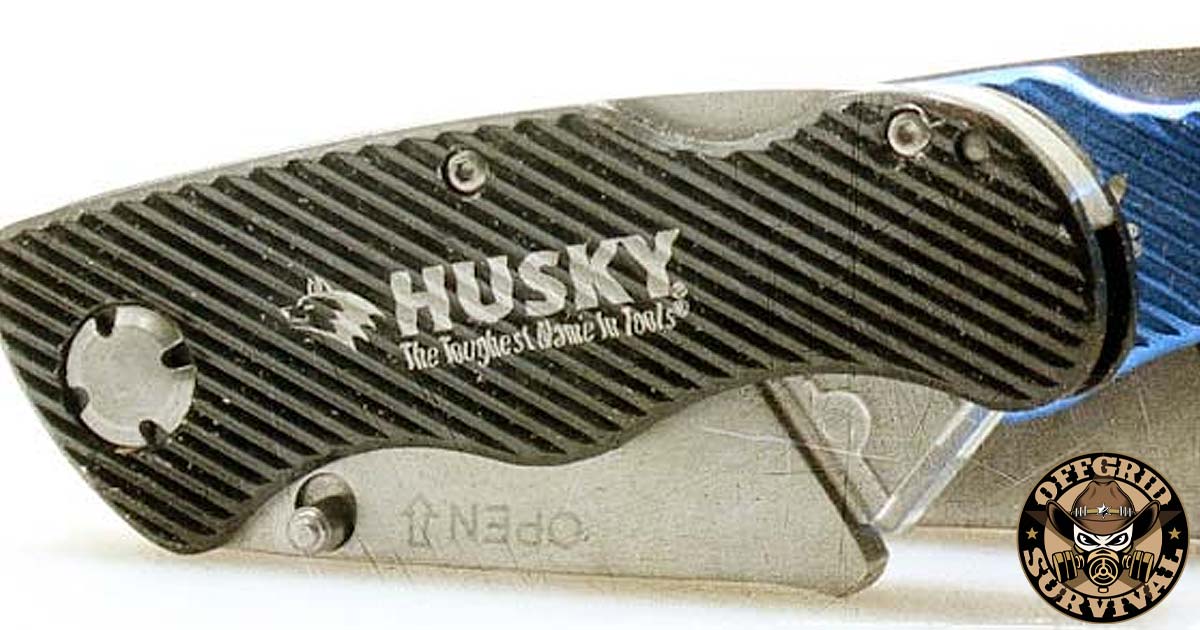
This little blade comes in very handy. I carry a couple of these in my truck and a few in my tool bucket. I break it out when I’m out on a job site to cut just about anything. You can find them at just about any hardware store or on Amazon for under $10 a piece including multiple blades.
What Knives to stay away from?
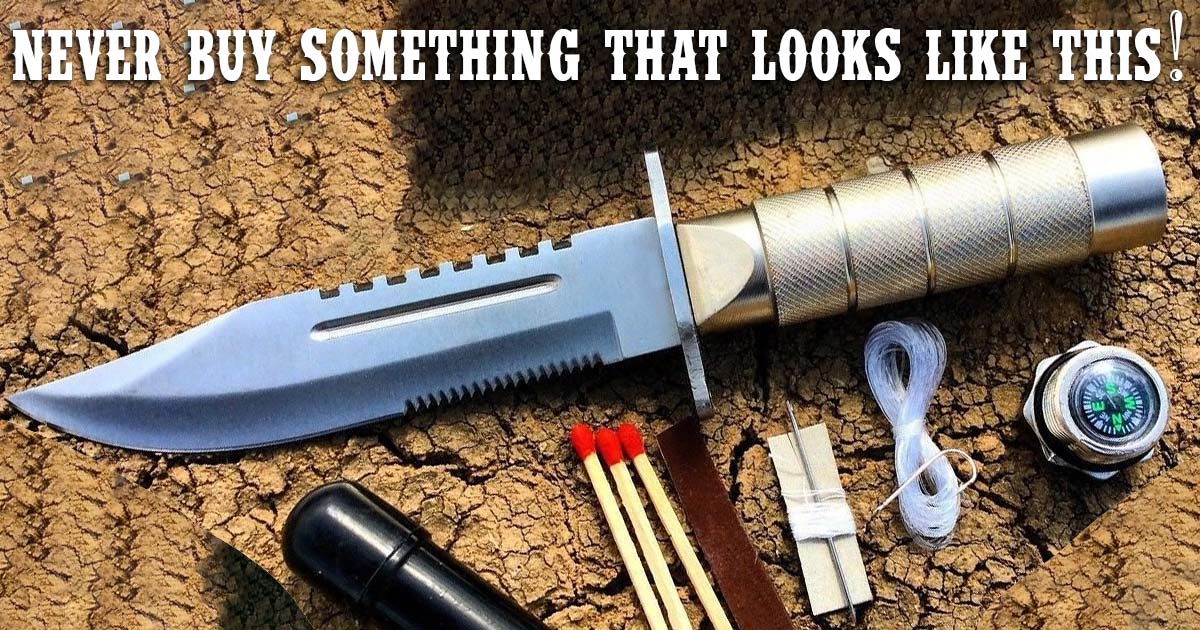
Survival Knives – When a company markets their blade as a “survival knife” they are probably not worth the weight in your bag.
Stay away from the ones that have a hollow handles, filled with so-called survival gear. The handles on these knives suck and are guaranteed to break when you need them the most.
Fancy Blades – If it looks like it belongs in a movie, chances are it’s of little use in an emergency situation. It may look cool as part of your collection, just don’t count on it to get you out of any sticky situations.
No matter what you carry, make sure you take care of your knife. A sharp knife is far safer than a dull one. When my blade is dull I sharpen it, if it beyond repair I get rid of it.
Looking for a Good SOG? This is what I carry…..



The CheaperThanDirt rough use knife is actually quite durable ~ $20.
My EDC knife is a classic Leatherman Multitool. Excellent investment – no frills, just built-to-last.
My primary bush knife is an ESEE RC-5. Built like a tank, guaranteed forever, no questions asked. I’ve now become a HUGE fan of ESEE knives.
Had a Ka-Bar – never held a good edge for me and the powdercoat chipped off readily.
Had a Gerber LMFII ASEK – the rubber overmolding on the handle started to peel after a few days.
Still have a Mora I paid $15 for – excellent knife, holds its edge very well… it even floats. Made of high carbon steel, so it WILL rust if left unattended.
When shopping for a knife, do consider:
1) The length and weight you need and find comfortable (some choppers may be too heavy, some bushcraft knifes may not be heavy enough)
2) The type of use you intend (a knife is not an axe, but you may need to baton through wood to split it, for instance)
3) The composition of metal (high carbon, stainless steel) and rockwell hardness rating.
4) Knife style – many sway by full tang-or-nothing designs, some prefer skeletonized designs to conserve weight, some hate serrations, some love clip points, etc.
5) Budget
Cheap isn’t always trash, but sometimes you do get what you pay for. Do your homework before you buy. If you grab the first thing you see for $20 at the local flea market you may regret it when you’re miles into the woods and that knife has a LOT riding on it.
my bob knives are a gerber lmf and a kabar bk2, but the blade i carry at all times is a SOG pentagon elite, its tough as hell and I use it every day. all the knives Ive listed are under a hundred, but worst case SHTF Ill take the lmf.
I have a plethora of fixed blade knives and agree that cheap, isn’t always junk. My EDC is a Condor Basic Bushcraft (5). I picked it up on eBay for around $30. Made in El Salvador, it has a full tang, improvised Scandi grind, carbon steel, sharpens easily, and takes a beating. I give it a “Thumbs Up” for anyone who needs a good working blade without a heavy price tag.
Thank you all for your input and God Bless.
“Cheap isn’t always trash” is absolutely true. I love my Mora!
i agree with the Mora, by far Mora’s are best.. light weight, tough as shit and cost around 20 dollars.
Not all hollow handled knives are crappy. Check out Chris Reeve knives, and there are others, I just cant think of their names. I think Randall knives markets a hollow handled knife, and it certainly wouldn’t be junk. Personally my idea for a survival type knife would be one that you could use for most “survival” related tasks, i.e.: cutting, prying, chopping, and at the bare extreme, fighting. But I think multi-tools are awesome “urban survival” knives. I would also want a good solid fixed blade to go along with it. Today, CRKT, TOPS Knives, and others offer good solid fixed blade knives for a good value. Another opinion of mine is that a sheath that holds all the necessary survival implements is more valuable than a knife that does.
The Best knife is like the Best firearm, it is the one you have with you when you have need of it. Choose a high quality folder for inside the pocket carry. If you always have it, it will always be there for You!
Keep sharp, in mind and blade.
Guess prefer Mora knifes from Sweden. Variations in price and seemingly very decent cheap ones.
(Weird two posts in a row but)
Cheap being – Mora 511 for 5 usd (carbon or stainless)
I agree that Moras just can’t be beat for all around use and price, but for tactical/self-defense use… would not be my first choice. Muli-tool with a can opener is a must. Can anyone recommend a good quality, decently priced fixed blade tactical/self-defense knife. I just sold a few and I’m in the market for one.
I carry a Cold Steel Mini Tac Kiridashi for EDC self defense. Small and light but size eficient, I got it for biomechanical cutting, but it’ll go thru a carotid, puncture a lung and liver, etc. as well as any 3 incher. I like the Safekeeper II as well, but push daggers, you know, about the same class as brass knuckles, you’d catch a case for wearing it, pretty much anywhere.
as for a real fighting knife, IDK, but i like Cold Steel stuff, maybe the OSS or Peace Maker? Not to mention bowies, that is what we use in this country. The SK-5 models have great reviews too. I’d really like a Gurka Kukri for a general purpose field blade. Super versatile, takes the role af a few different knives and tools.
Bushman and Canadian Belt Knife can definately find use in survival gear too.
My Gerber Big Rock is a excellent choice for those who have limited budgets. The handles will come off if they wear out, so that no big issue to me. Some of you carry machete looking knives….i want to keep it simple.
Gerber LMFII Infantry – Awesome bt of kit that i’ve used to make shelters etc with, takes a real hammering and retains a good edge.
Great post and great comment from Dustin.
Re: Denny Symes’ comment about hollow-handled knives, no, not all hollow-handled knives are junk, but the cheap ones certainly are. And the post did specify hollow handles filled with stuff, which I doubt the Chris Reeves knife is. And I believe the CRK is made from one piece of steel, not a blade attached to a hollow handle via flimsy joint like most of those saw-backed, hollow-handled, piñata knives filled with fishing line and compasses are. Unfortunately, any decent hollow-handled knife is going to be out of the price range of the very demographic they most appeal to: teenage boys and younger men. So for them, their intro to “survival” knives (sometimes knives in general) is pure junk.
I SEARCHED FOR A LONG TIME(OVER 6 MONTHS)FOR THE RIGHT BUSH SHEATH KNIFE. I PICKED THE KERSHAW D2 OUTCAST. THIS KNIFE WEIGHS IN AT 22 OZ,COMES WITH A KYDEX SHEATH,10″ BOLO STYLE BLADE,16″ OVERALL. SOME WILL SAY IT’S A BIT HEAVY,BUT IT WILL DO EVERYTHING AN AXE WILL AND MORE. I HAVE USED IT TO FELL 8″ HARD WOOD TREES,DIG PRIVY HOLES,SPLIT FIRE WOOD. IT HAS YET TO LET ME DOWN. THE EDGE RETENTION IT GREAT. FOR $70.OO DOLLARS IT CAN’T BE BEAT. i ALWAYS CARRY MY LEATHER MULTI TOOL AS A “FIRST” KNIFE. GIVE THE OUTCAST A LOOK. THANKS!
I have used many knives over the last 35yrs.ranging from Sears Roebuck, Gerber and Al Mar, for hunting,combat carry and survival. The one that I have consistantly returned to using is a Camillius K-Bar. Mine has always held a pretty good edge and I have not had any problems with the finish degrading. As with any knife, you should keep it clean and the edge touched up. If I had to hit the wilderness tomorrow, I would take my Leatherman and my K-Bar.
Try checking out a local gun or knife show. Sometimes I have found used knives that are excellent and for almost 50
% of the price of new. I prefer a folding CRKT in a 5 inch blade and also a fixed 7 to 9 inch blade like a K Bar.
Definitly also a good multitool for cutting things like wire or heavy paracord.
I’d highly suggest 2 knives , ..I always carry a leatherman “Sideclip” and I have Randall made 14 with a stainless steel blade in my “Bug-out-bag”
Sometimes a pocket knife is too little and a sheath knife is too much.
Btw , Buy a quality knife sharpener and learn to use it to keep all your knives sharp.
Finding a good, solid knife that will be with you for a long time is very similar to finding the right partner. A few people get lucky right from the start, most bumble through a bunch to finally find “the one”, and for those folks who haven’t, they just have to keep looking and trying.
I think I would trust the Mora for most of a day’s activities, but, I absoultely LOVE ESEE KNIVES! They have an awesome selection designed for those from the amateur to the pro. They are well built and have a NO QUESTIONS ASKED LIFETIME WARRANTY!
Fallkniven A1 is what I settled on for the BOB. I was sold on the strength, durability tests conducted and although pricey I would trust it to hold up to a shtf task. It also would lash nicely & serve as a spear tip.
A knife is a personal thing. My neighbor asked me what knife to buy her husband, and ended up talking with him about it instead of just buying one for him. The debates go on, fixed vs. folder, partially serrated vs. plain, handle material, steel, blade configuration. They make a lot of different knives because everyone is different. Personally, EDC – Kershaw Ken Onion Shallot with ZDP-189. Hunting – Buck 119. Fishing/Deboning – Victorinox 47513. Kid’s first knife – Gerber 44576 lock back. Multi-tool – Leatherman (I’ve got two different models.) Truck knife – one I made from a metal file in high school. Celebrate diversity! (I’m about to google Mora…)
Don’t know if anyone has seen that gerber teamed up with Bear Grils from man vs. Wild. I received the fixed blade as a fathers day gift. Its a really nice blade and it has a bunch of survival perks.